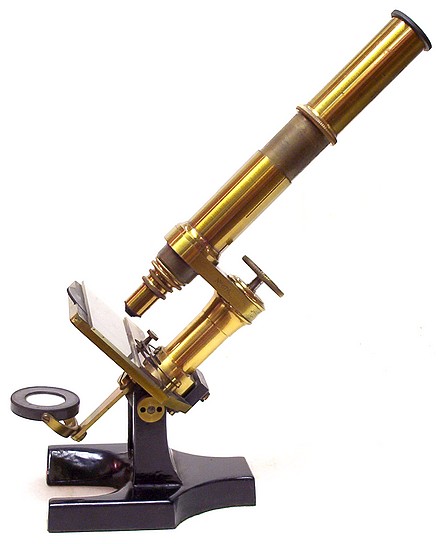
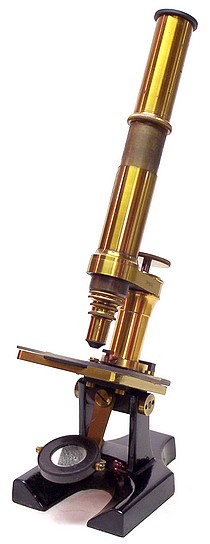
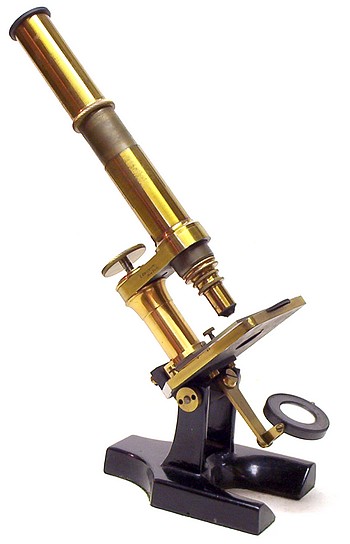

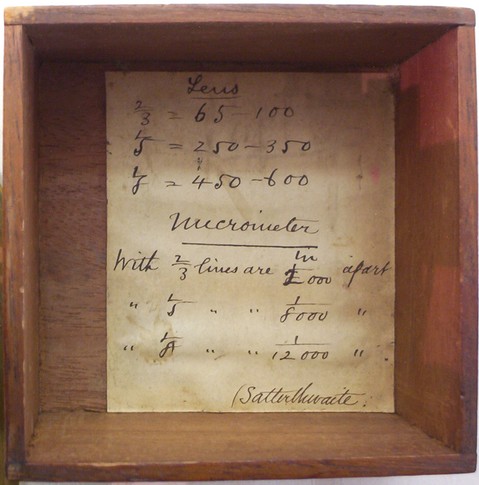
Attached to the bottom
of the accessory drawer is a hand-written magnification
chart. Of significance is that it is signed
at the end with the relatively uncommon
name "Satterthwaite". The literature
indicates that a Thomas Edward Satterthwaite,
Professor of Histological and Pathological Anatomy in
the New York Post-Graduate Medical College, was an
active microscopist during the latter part of
the 19th century. Might this microscope be
associated with him?
A quote from his book
A Manual of Histology, 1882 suggest
that he was familiar Grunow instrumentation as
follows: "For ordinary histological purposes, a
lens that will show the oscillatory movement in the
mucous or salivary corpuscles is sufficiently high
for practical purposes. This is accomplished by the
ordinary student's one-fifth of Grunow, for
example." Among the lenses associated with
this microscope is indeed a 1/5 Grunow student's
objective. Overall, it is likely that this
microscope was an instrument in the
laboratory of Professor Satterthwaite.
The following biography
was extracted from History of the Class of 1864,
Yale College 1860-1985:
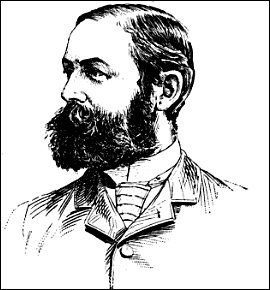
Thomas Edward
Satterthwaite, M.D., (Belleville, N. J.), son of
Thomas Wilkinson and Ann Fisher (Sheafe)
Satterthwaite, was born March 26, 1843, at Spuyten
Devil, Westchester Co., N. Y., which is now within
the limits of New York City. In college he was a
member of Linonia, Varuna Boat Club. In Sept., 1864,
he entered the Scientific School of Harvard
University, in the department of comparative anatomy,
and became a private pupil of Jeffries Wyman. In
November he attended one course of lectures in the
Harvard Medical School, and then reentered the
medical department of the Scientific School, where he
remained until July, 1860. In Oct., 1865, he entered
the College of Physicians and Surgeons, New York, and
received the degree of M.D. from that institution in
March, 1867. He was appointed an Interne of the New
York Hospital, August 7, 1867, where he served for
two years. He then went to Europe and continued his
medical studies in Vienna. The Franco Prussian war
breaking out, he entered the Prussian army, where he
held the position of Assistant Surgeon and later of
full Surgeon, remaining in the service till the
spring of 1871. For these services he received from
the Emperor William the Decoration of the Iron Cross.
On his return to this country (December, 1871), he
settled in New York City, where he has since
practiced his profession. In 1872 he was appointed
Microscopist and subsequently Pathologist to St.
Luke's Hospital, holding these positions about twelve
years; in 1873, Pathologist to Presbyterian Hospital,
holding it fifteen years; in the same year he opened
a private Laboratory for instruction in Histology,
which was continued for seventeen years. In 1880, and
1881 he was President of the Pathological Society of
New York ; in 1882 he was instrumental with others in
founding the New York Post Graduate Medical School
and Hospital and was its secretary for the first two
years of its life, being also Professor of Pathology
(1882-84), Professor of General Medicine (1884-90)
and Vice President (1890) of the same. He is
consulting physician to the Orthopaedic Hospital, and
the Northeastern Dispensary, and President of the
Babies' Hospital. In 1881 he published simultaneously
in New York and London a " Manual of Histology''''
which has gone through several editions, and in 1887,
in Detroit, a work on " Practical Bacteriology." He
has also contributed extensively to various medical
journals. A list of his published papers may be found
in Atkinson's " Physicians and Surgeons of America "
under his name, where is a biographical notice, as
also in Johnson's Encyclopaedia. He is a member of
the American Academy of Medicine, the New York
Academy of Medicine, the Medical Society of the
County of New York, the Medical Society of the State
of New York, International Medical Congress, N. Y.
Physicians Mutual Aid Association, Geographical
Society, Genealogical and Biological Society and of
the University and Century Clubs.
The following is his
obituary as published in the American Decades:
Thomas Edward
Satterthwaite, 91, physician and author; while
studying in Vienna after receiving his M.D. from
Columbia University, the Franco-Prussian War broke
out and Satterthwaite received a commission as
assistant surgeon in the Prussian army; on his return
to the United States, he worked as a microseopist and
pathologist at various New York City hospitals and
founded and cofounded the Babies' Hospitaland
Post-Graduate Medical School, New York City. He died
19 September 1934.
This
microscope dates from around 1880. The Grunow
brothers, Julius and William, emigrated from Germany
to New York around 1849. They started in the
scientific instrument business by first working for
the optician Benjamin Pike of that city. By 1854,
they began their own operation in New Haven CT where
they concentrated on the production of microscopes.
By 1864, they were back in New York. Some years
later, the partnership ended. J. Grunow continued on
to produce microscopes up to around 1892. The total
output of the Grunows was limited in comparison to
some other contemporary firms; on the basis of the
observed serial numbers, they manufactured just over
one thousand microscopes in total.





